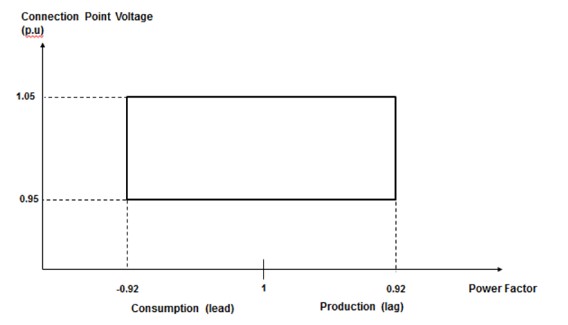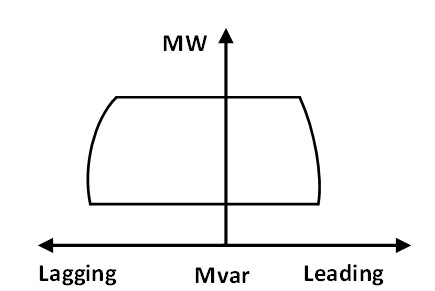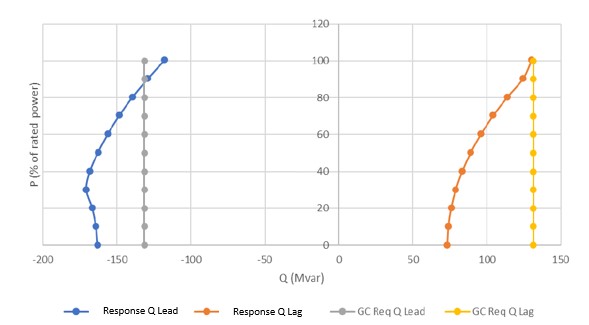

Shahab Khan & Mahmoud Elkazaz
In this series of short technical articles, we look at various topics that illustrate the complexity of renewables as a concept within the ongoing energy transition. Here, PSC’s Shahab Khan and Mahmoud Elkazaz discuss reactive power capability requirements in modern electrical grids.
Reactive Power Capability Requirements
Are you familiar with reactive power capability requirements in electrical grids? Reactive power is a crucial component of electrical grids that helps maintain voltage stability and ensure efficient energy transmission. In this article, we’ll dive into the world of reactive power capability requirements and explore why they are essential for maintaining a reliable electricity supply to customers.
Reactive power capability and its requirements in relevant codes
Reactive power is either generated or absorbed by equipment in the electrical network. For example, predominantly capacitive cables generate reactive power whereas reactive power absorption occurs across the transformer. Synchronous generators have the capability to generate or absorb reactive power based on their excitation. For generators, the lagging power factor implies that it is generating reactive power, while for loads it implies the absorption of reactive power. The leading power factor, on the other hand, for generators implies the absorption of reactive power, while for loads it refers to the generation of reactive power.
Relevant regulatory codes require plants to have a reactive power capability to maintain voltage within specified ranges under various conditions. The envelope defines the reactive power capability required from a plant at different voltages. A plant must be able to operate at or below the maximum and minimum reactive power levels specified in the envelope at all times. A typical reactive power capability envelope is shown in Figure 1 [1].

Figure 1 Reactive power capability for type C and D synchronous power generating modules [1]
Inputs required for the reactive power capability analysis.
Following are some of the inputs required to perform a reactive power capability study for a plant.
- System technical performance requirements and specifically reactive power capability requirements from the applicable code. This is usually defined according to the voltage level of the connection i.e., whether it is distribution or transmission connected.
- Electrical model of the plant with all the network components, e.g., transformers, cables, overhead line, auxiliary load, generator in one of the power system simulation software e.g. DIgSILENT PowerFactory, etc.
- P-Q capability curve of the plant. This data can be obtained from the manufacturer’s data sheets. For example, every synchronous generator has its own P-Q capability curve, and this information should be available from the machine documentation or the manufacturer. The capability curves define the operating characteristics of the generator in terms of MW and Mvar. The reactive power capability of the conventional synchronous generator is typically described by a “D curve” that covers the range from zero to rated output as shown in Figure 2.

Figure 2: P-Q capability curve of a typical Synchronous generator considering plant minimum load
Reactive power capability analysis and the expected outcomes
To check whether a plant is capable of meeting the reactive power capability requirement, a reactive power capability study is carried out. This involves performing the loadflow analysis without any external reactive compensation. Reactive capability is assessed under several different scenarios considering the extreme ends of the operational voltage range (e.g. 0.95 pu and 1.05 pu in Figure 1) and the power factor at the POI.
The analysis outcome highlights whether or not the plant complies with reactive power capability requirements. If there is non-compliance observed in any of the studied scenarios then the need for external compensation in terms of Variable Shunt Reactor (VSR), Static Var Compensator (SVC) or Static Synchronous Compensator (STATCOM), etc. is worked out to ensure compliance requirements are met considering external compensation.
When do you start considering an external compensation need?
The requirement for external reactive power capability is determined from a site-specific reactive capability study and the need to maintain reactive power within acceptable levels. System operators use this information to decide whether or not it is necessary to bring in external sources of reactive power. If they conclude that it is needed, they will work out how much is required and what kind of equipment would be best suited to providing it.
If needed to meet interconnection requirements, the reactive power capability of the generation plant can be further enhanced by adding n SVCs, STATCOMs, and other reactive support equipment at the plant level.
To determine the external compensation requirement both steady state and quasi-static analysis is carried out. Figure 3 shows the reactive power output from the plant at the POI for both the leading and lagging power factor, with unity voltage at POI, along with the requirements (grey and yellow lines) from the relevant code. Non-compliance can be observed under both lagging and leading power factor operation except when power output from the plant is between 0-90% of the rated power for the leading power factor.
Plants comprising of synchronous generators do not require external compensation for compliance requirements. However, inverter-based resources generally require external compensation to comply with the relevant code’s reactive power requirement.

Figure 3 Reactive power capability at POI
Interesting observations about reactive power capability for Battery Energy Storage System (BESS)
BESS is now a key component in the modern electric grid. The BESS should be able to provide reactive power when both charging and discharging to maintain grid stability. If the BESS cannot provide reactive power when needed, it could cause grid instability and blackouts.
Following are some of the interesting observations about the reactive power capability of the BESS:
- The BESS can provide or absorb reactive power at normal operation. It can also provide reactive power to the system under fault conditions provided there are no capacity constraints (e.g., cooling off period).
- Provision of reactive power from BESS is a trade-off between active and reactive power. At full active power, reactive power provision is at minimum while at zero active power, full reactive power can be provided. To enable the reactive power supply when operating at the rated active power, inverters need to be sized larger. High transformer loading values and/or BESS heating up are the main constraints if the BESS operates at high reactive power for a long time (e.g., 24 hours without stopping).
- Small domestic BESS installations do not normally provide reactive power support to the network but may do so as part of aggregation schemes that provide ancillary services.
Using reactive power capability to provide flexible reactive power support
The reactive power capability of a plant can be used in the reactive power market to provide flexible reactive power support to the network. The use of flexible reactive power services provides one method to operate the existing network more efficiently, though new services and optimization in this area are needed to release the capacity for accelerated Low Carbon Technologies (LCT) connections. When designed to do so, modern grid-forming inverter-based Distributed Energy Resources (DERs) can vary their reactive power production, impacting voltage at the POI. If this function is enabled, DERs can potentially provide the required reactive power as an alternative to installing distribution capacitor banks or reactors.
Final words
There are a number of key takeaways that we would like readers to remember. Firstly, connecting any generation plants to the T&D networks requires compliance with the minimum reactive power capability requirements stated in the relevant code. Secondly, with increased DER penetration, utilities will have to contend with voltage profiles that change drastically throughout the day. Using reactive power dispatch to deliver localized voltage support in addition to or as a replacement for conventional measures can enable DERs to provide grid services.
References
| [1] | National Grid Electricity System Operator Limited, “THE GRID CODE, Issue 6, Revision 16,” 2023. |
| [2] | Sandia National Laboratories, “Reactive Power Capability and Interconnection Requirements for PV and Wind Plants”. |
If you’re looking for help with your power system studies, here’s more information about our capabilities. Please contact us to get started!
Series links
The complexity of renewables, Part 1 – PSC Consulting
The complexity of renewables, Part 2 – PSC Consulting
The complexity of renewables, Part 3 – PSC Consulting
The complexity of renewables, Part 4 – PSC Consulting
The complexity of renewables, Part 5 – PSC Consulting
The complexity of renewables, Part 6 – PSC Consulting
The complexity of renewables, Part 7 – PSC Consulting
The complexity of renewables, Part 8 – PSC Consulting
The complexity of renewables, Part 9 – PSC Consulting
